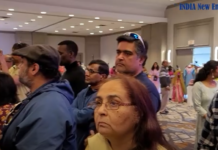By Doug Rand
(Editor’s note: Doug Rand worked on immigration policy as Assistant Director for Entrepreneurship in the Obama White House, and is now the co-founder of Boundless Immigration, a technology company that helps families navigate the immigration process.)

It’s no secret that 2018 was a tough year for the legal immigration system, as we predicted this time last year.
As 2019 begins with a government shutdown over border wall funding, it’s easy to overlook the fact that the vast majority of immigration changes are happening behind the scenes, deep within the executive branch.
You probably won’t see action in Congress. There’s always the slim chance that Congress could pass a narrow bill that provides relief for Dreamers with stepped-up border security, but the White House torpedoed just such a deal last year and those fundamental dynamics haven’t changed.
You’ll definitely see action in the courts, as advocates and the government engage in high-profile litigation over the ultimate fate of Dreamers, Temporary Protected Status (TPS), asylum-seekers, refugees, and immigrant detainees.
Less obvious, but just as inevitable, are further efforts by this administration to constrict the number of immigrants who can obtain (or hold on to) their work permits, visas, green cards, and even U.S. citizenship.
The upshot is legal immigration is going to get more difficult, and tomorrow’s rules will be even more strict than today’s. Anyone who is eligible for a green card or naturalization should begin their applications immediately. The longer you wait, the more likely you’ll be subject to tougher rules and a punishing backlog that could extend your wait time months or even years.
When it comes to the complicated machinery of our legal immigration system, here are the stories — and the lawsuits — to watch in 2019:
1. Cutting Legal Immigration in Half
If you’ve already read about the “public charge rule,” you may know that this proposed policy would penalize lower-income immigrants for using social safety net programs that they’re otherwise legally entitled to use. You may not know that this policy would slash legal immigration by well over 50%, by denying both green cards and temporary visas to immigrants based on a whole range of factors far beyond using public benefits — such as not earning a middle-class income, not being in perfect health, not speaking fluent English, not having a perfect credit score, and more.
Look for three different federal agencies to make new moves to advance “public charge” policies in 2019, for three very large but different populations:
VISA APPLICANTS IN THE UNITED STATES
On October 2018, the Department of Homeland Security (DHS) unveiled its proposed “public charge rule,” a backdoor wealth test that would separate nearly 200,000 married couples each year, harm U.S. businesses, and cost up to $13 billion in annual compliance costs alone. By the government’s own estimate, this newly restrictive test would apply to 900,000 applicants for visa extensions and green cards every year. Before DHS can implement this rule, however, it will have to process and respond to the over 200,000 public comments it received — a task that could last well into 2019.
VISA APPLICANTS ABROAD
Meanwhile, the Department of State processes some 13 million visa and green card applications each year at U.S. consulates and embassies all over the world, and has been applying a tougher “public charge” test since January 2018. Consular offices have been instructed to reject applicants if they are deemed too poor, old, or unhealthy. The city of Baltimore recently sued the State Department to block this policy.
PERMANENT RESIDENTS
At some point in 2019, the Department of Justice (DOJ) may propose its own new “public charge” standards that could expand the government’s ability to deport immigrants who already have green cards, creating immense new uncertainty for some 13 million lawful permanent residents of the United States.
2. Denaturalizing and Deterring New American Citizens
Becoming a U.S. citizen brings great privileges and responsibilities, and the naturalization process is not easy. Once an immigrant has taken the Oath of Allegianceand becomes a U.S. citizen, they can rest assured that they will be treated the same as native-born U.S. citizens.
But this sense of security is under threat.
Last year, the director of U.S. Citizenship and Immigration Services (USCIS) launched a new office dedicated to ramping up the number of naturalized Americans who are ultimately stripped of their U.S. citizenship for past infractions. Commonly known as the “denaturalization task force,” this effort could lead to an unprecedented wave of Americans losing their citizenship in the years to come.
At the same time, it’s become more difficult to become a citizen in the first place, and USCIS may create new hurdles in 2019:
Growing wait times: The government’s processing time for citizenship applications is now over 10 months on average, nearly doubling between 2014 and 2018. Advocacy groups have sued to uncover whether these increasing wait times and backlogs are intentionally discriminatory.
Higher fees: USCIS is chipping away at longstanding policies that reduce fees lower-income citizenship seekers. While lower-income applicants can still apply for a waiver of the full $725 naturalization fee, USCIS plans to make this much more difficult in 2019, potentially reducing the number of fee waivers by two-thirds. And depending on how the above-mentioned DOJ public charge rule shakes out, merely applying for a fee waiver could make some permanent residents deportable.
More red tape: USCIS already eliminated the fingerprinting exemption for applicants aged 75 and older. Now, the agency has very quietly proposed to change the naturalization application form in 2019, asking much more expansive questions and requiring many applicants to dig up 10 years of prior international travel records (rather than the longstanding status quo of 5 years). Meanwhile, USCIS also recently increased scrutiny on immigrants with disabilities who seek an exception to the English and civics testing requirements for U.S. citizenship, and might go further in 2019 with plans to tighten up medical certifications of disability.
3. Pricing Out Low-Income Immigrants
Nearly every federal agency that helps run the U.S. immigration system could hike its fees in 2019.
- Immigration and Customs Enforcement (ICE) has already announced plans to increase student visa fees by up to 75%. It also has a brand-new visa security program fee under development for international travelers.
- The State Department is working to increase several fees.
- USCIS plans to overhaul its fees across the board. That’s not unreasonable for an agency funded almost entirely by user fees, but it’s possible that this administration will use this regulation more aggressively — for example, to completely eliminate fee waivers for low-income citizenship applicants.
USCIS could also make its services more expensive in other ways that are less direct but no less burdensome. For example, while it’s outstanding that citizenship applicants now have the option to file electronically, immigrant advocates are deeply concerned about the agency’s plan to “mandate electronic submission for all immigration benefit requests.” How would such a mandate affect lower-income immigrants, who are more likely to face barriers in using the required technology?
4. Driving Up Denials and Deportations
Last year, USCIS issued denials 37% more often than in 2016, including applications for work permits, travel permits, green cards, H-1Bs, and other visas.
This will probably get worse in 2019, as USCIS ramps up its “zero-room-for-error” policy toward legal immigration. First, it will be much more difficult for applicants to correct minor mistakes and avoid the expensive and time-consuming prospect of starting over, since USCIS plans to stop issuing as many Requests for Evidence.
And the stakes are even higher for anyone who lacks immigration status. In 2019, USCIS will fully implement a new policy of initiating deportation proceedings against anyone who is out of status at the moment their application is denied — whether they were always undocumented or they only fell out of status while waiting for the government to respond.
5. Creating 100,000 “Involuntary Housewives”
Skilled workers with H-1B visas are authorized to work in the United States, but until 2015, their spouses (who have “H-4” visas) were not allowed to obtain their own work permits. That’s when a new regulation made it possible for these spouses to work, during the years-long wait for their families to obtain green cards.
In 2019, USCIS plans to roll back this policy, making it impossible for over 100,000 individuals to continue working in the United States, despite the fact that they already have an approved green card petition. Most of these H-4 workers are Indian, female, and highly educated.
A grassroots group of allied immigrants recently intervened in a lawsuit to defend the legality of these work permits.
6. Turning Away International Students
U.S. colleges and universities have seen international student enrollment plummet over the last two years, and 2019 may be even more challenging.
Going forward, DHS will bar international students from the United States for up to 10 years based on any visa infraction, no matter how minor or innocent. A number of universities have sued to block this move.
Meanwhile, DHS is working on a plan to shorten the time that international students are allowed to remain in the United States and require more frequent extensions. (This is on top of the State Department’s previous move to shorten visas from 5 years to 1 year for Chinese students researching aviation, robotics, and advanced manufacturing.)
Another big story to watch in 2019 is the fate of the Optional Practical Training (OPT) program, which allows international students to work for U.S. companies for 1–3 years after graduating. The OPT program allowed 1.5 million graduates of U.S. universities to stay and work between 2004 and 2016.
Major business associations have moved to join a lawsuit in defense of OPT, fearing that the Trump administration plans to side with opponents of the program in court or eliminate it entirely through regulation. (This is not altogether paranoid, given that DHS previously attempted to restrict OPT job placements through a barely-noticed website change, leading to yet another lawsuit.)
7. H-1B Visas in Chaos
This administration has taken a dim view of the H–1B visa program, which allows U.S. employers to bring in over 85,000 high-skill workers each year. Opponents believe that many of these jobs should be going to native-born workers.
The big H-1B story to watch in 2019 is how exactly DHS plans to flesh out its broad regulatory plan to (a) “revise the definition of specialty occupation to increase focus on obtaining the best and the brightest foreign nationals,” (b) “revise the definition of employment and employer-employee relationship to better protect U.S. workers and wages,” and (c) “ensure employers pay appropriate wages to H-1B visa holders.” If this plan is ultimately enacted, and survives court challenges, it could dramatically changewhich workers are eligible for H-1B visas.
Meanwhile, there’s no shortage of other curveballs being hurled at the H-1B system:
- USCIS has proposed to overhaul the way it runs the “H-1B lottery,” where employers vie for a limited number of visas each April. Some experts fear that by rushing into this new online registration system, the agency could cause uncertainty or even chaos this spring.
- While H-1B visas have traditionally been granted for 3-year renewable periods, USCIS has started to limit some of these visas to only a few days, or even negative days (imagine getting an approval notice for your visa only to learn that it has already expired). A recent lawsuit is challenging the legality of this unprecedented practice.
- USCIS previously issued a memo restricting the ability of companies to place H-1B workers at third-party worksites, leading to another lawsuit.
- Then there was the time that USCIS made it impossible for some lower-salary workers to meet the H-1B visa’s “speciality occupation” requirement. If you guessed that this would spawn yet another lawsuit, you’d be right.
Combine all of this with moves by USCIS to require duplicative H-1B paperwork every 3 years, suspend fast-track processing at a moment’s notice, increase the Request for Evidence rate by 45% and the denial rate by 41%, and it’s no wonder that many companies and immigrants believe that the H-1B program is under siege.
8. Closing the Door to Entrepreneurs
The International Entrepreneur Rule is an Obama-era policy to make it easier for startup founders to build companies in the United States and employ American workers. The Trump administration tried to kill this program overnight in 2017, got sued by several would-be immigrant entrepreneurs, got ordered by a federal judge to implement the program, did so begrudgingly, and then issued a proposed regulation last year to ultimately scrap the International Entrepreneur Rule once and for all.
Setting aside the negative economic impact of such a move, the International Entrepreneur rule also serves as a bellwether for other immigration policies in 2019. It was the first Obama-era immigration regulation that the new administration tried to overturn, and now DHS has some 2 dozen other regulatory actions on its menu. If the final cancellation of the International Entrepreneur Rule continues to fall behind schedule, the rest of these regulations may be delayed as well.
9. Ballooning Backlogs
Over the past 2 years, wait times have increased dramatically for families, workers, and even crime victims navigating the legal immigration system — with some waiting up to 8 times longer than in 2014. (The government’s public data doesn’t go any further back in time.)
These delays create immense uncertainty at best and can have life-altering consequences at worst. (Remember, DHS has a new policy of initiating deportation proceedings against anyone who loses their immigration status while waiting for a form to be processed.) Unfortunately, 2019 could set new records for administrative delay.
TOO MANY INTERVIEWS
One major contributor to growing wait times was a 2017 USCIS policy to require an in-person interview for anyone applying for an employment-based green card (about 122,000 people each year) or family members of refugees and asylees applying for a green card from within the United States (about 46,000 people each year).
At the end of 2018, USCIS quietly implemented a new obstacle for over 166,000 married couples each year: Nearly all of them will now be required to attend an in-person interview 2 years after receiving a marriage-based green card, when they will have to prove the authenticity of their marriage for a second time.
Since USCIS field officers have limited time (and there’s no evidence of a new hiring surge), this doubling-down on new interviews is bound to exacerbate backlogs for many other visas, green cards, and U.S. citizenship as well.
MORE RED TAPE IN THE WORKS
A close look at the DHS regulatory agenda for 2019 reveals a looming wave of planned changes that could slow down the legal immigration system even more:
- If USCIS ultimately enacts the public charge rule (as described above), over 14 million people could suddenly find themselves required to fill out a complex new form that Boundless estimates will likely take about 18 hours to complete (400% longer than the USCIS lowball estimate) — and that’s not including the extra time it will take for USCIS officials to evaluate these forms using a mind-bendingly complex new “public charge” test.
- USCIS wants to end “concurrent filings” for many green card applicants, which would mean that families can no longer put all of their green card forms in the same filing package. This is the kind of policy change that is both incredibly boring and incredibly consequential — it would cause significant new delays.
- USCIS also wants to unburden itself of the current requirement that it process work permit applications from asylum seekers within 30 days.
- What does USCIS mean by its plan to “allow for the expansion of the types of biometrics required to establish and verify an identity”? Don’t bet on things getting any easier.
- Same with this plan to “streamline the existing processes for filing motions and appeals.” We shall see …
FOLLOW THE DATA
Here is a summary of the government’s own data on processing times for some the most common legal immigration applications.
| The Steady Rise of USCIS Processing Times (fiscal year average, in months) | |||||
| Form | FY2014 | FY2015 | FY2016 | FY2017 | FY2018 |
| Fiancé(e) visa (I-129F) | 3.5 | 3.8 | 2.9 | 4.1 | 6.7 |
| Family-based green card sponsorship(I-130) | 6.8 | 6.1 | 6.0 | 7.7 | 9.7 |
| Employment-based green card sponsorship (I-140) | 2.9 | 5.1 | 5.7 | 6.9 | 7.8 |
| Family-based green card application(I-485) | 5.7 | 6.6 | 6.8 | 8.4 | 11.1 |
| Employment-based green card application (I-485) | 4.5 | 6.5 | 6.8 | 8.1 | 11.0 |
| U.S. citizenship (N-400) | 5.2 | 5.8 | 5.6 | 8.1 | 10.2 |
| Travel permit (I-131) | 2.1 | 2.3 | 2.3 | 3.0 | 3.9 |
| Work permit (I-765) | 2.1 | 2.4 | 2.6 | 3.1 | 4.1 |
| Shift from conditional to permanent spousal green card (I-751) | 5.7 | 7.4 | 9.1 | 11.8 | 16.1 |
| Shift from conditional to permanent investor green card (I-829) | 9 | 13.1 | 19.1 | 27.7 | 27.1 |
| T visa for trafficking victims (I-914) | 5.8 | 6.4 | 7.9 | 9.0 | 11.4 |
| U visa for crime victims (I-918) | 5.0 | 11.4 | 22.1 | 32.1 | 40.5 |
| Various waivers | 6.8 | 10.0 | 16.9 | 23.6 | 29.1 |
10. The Element of Surprise
While the above list of looming immigration changes is long (congrats for reading this far), it is almost certainly incomplete. If 2019 is anything like 2018, the year will be full of easy-to-miss Friday-afternoon policy announcements that nobody saw coming.
It’s also worth keeping an eye on previously tabled policy changes that could come back to life:
- Remember that time Stephen Miller wanted to cancel the visas of all 350,000 U.S. university students from China?
- How about when DHS shelved a plan to terminate H-1B extensions and boot from the United States perhaps a million people on the green card waiting list?
- The State Department may still be considering “major reductions” for the J-1 cultural exchange visa, including the program for au pairs who provide child care for U.S. families, as well as the summer work-travel program.
- And don’t forget about the new National Vetting Center, a Trump administration creation that quietly commenced operations last month and could have huge sway over international travelers.
Bottom line: In the year ahead, expect many more regulations, restrictions, and lawsuits with impacts throughout the legal immigration system.














